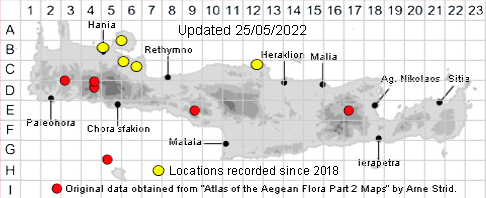
SPECIES DESCRIPTION
ROMULEA LINARESII subsp. GRAECA
Family and Genus:- See- IRIDACEAE
Common Names:- None
Homotypic Synonyms:- None
Meaning:- Romulea (L) For Romulus, founder of Rome.
Linaresii (L) Thread-like, flax.
Graeca (L) Grecian, Greek.
General description:- Herbaceous plant, with erect, hairless stems.
Scape:-
1) With 1-4 cauline leaves, 1- to 2(-3)-flowered.
Leaves:-
1) 3-6.
2) Basal, 25-200 x 0·9-1·5 mm, mostly recurved and procumbent.
Flowers:-
1) Violet-purple, concolorous.
2) Pedicels, short, not elongating after flowering.
3) Bract, 0·9-1·6 cm., sometimes tinged with purple, herbaceous, with a scarious
margin.
4) Bracteole, 0·9-1·6 cm. with a narrow green keel or almost completely scarious,
spotted with reddish-brown.
5) Perianth, 1-3·2 cm, the tube 4-7 mm, segments acute.
6) Filaments, purple, hairy at the base.
7) Anthers, reaching 1/2-2/3 of the way up the segments.
8) Stigmas, below the top of the anthers.
Fruit:-
1) Capsule, obovoid.
Key features:-
1) Bracteole, mostly scarious, weakly veined.
2) Flowers, violet-blue the throat the same colour as the tepals.
3) Stigmas, below the top of the anthers.
Habitat:- Seasonally damp spots in open dry shrubby vegetation, pastures and
open woodland. 0-1200 m.
Distribution:- Scattered throughout Greece and Aegean region. Rare on Crete,
known from a few scattered locations on the Lefka Ori and the Dikti mountains.
With new location discovered in the north west.
Flowering time:- Feb-Apr.
Photos by:- Fotis Samaritakis
